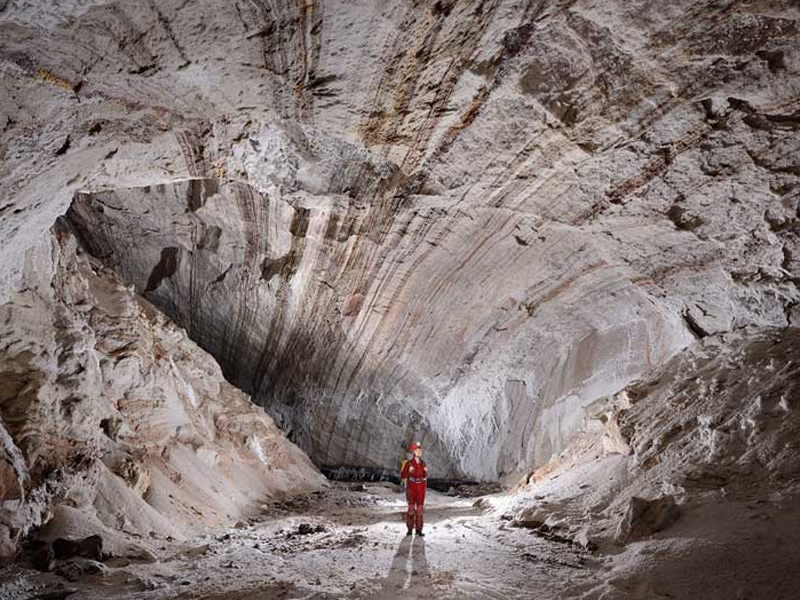The Caves in Iran are among the most beautiful and exciting attractions in the world. Iran is a land that boasts numerous caves, each with its special marvels. By entering these caves, you can witness a world of wonders with your own eyes and delight in the beauty they offer.
A mysterious and enigmatic world lies hidden among these caves. Upon entering, you will undoubtedly be intrigued by unfamiliar and peculiar sounds, sounds unlike anything you have heard before. In the beautiful country of Iran, there are approximately 2,500 caves. Iranian caves are abundant, and we will briefly mention a few of them.
This diversity in the number of caves in Iran has transformed the vast country into an eternal paradise for spelunkers. Cave explorers from different parts of the world travel to Iran for caving adventures, enticed by the diversity and beauty of its caves. in this article from Eligasht, we introduce some of these mysterious caves in Iran to guide you in choosing your destination.
Book Iran Air flights from London to Tehran and Tehran to London with Eligasht UK:
Katale Khor Limestone Cave
This cave is considered one of the largest caves in Iran. It is composed of limestone. The cave features various stalactites and multiple levels. The cave was discovered approximately 1,300 years ago. The purity of the limestone in the cave allows the light to pass through the stalactites beautifully and transparently. The passage of light through the stalactites inside the cave creates a phenomenon known as light refraction, adding a special beauty to the cave. It might be interesting to note that the end of the cave leads to the Ali-Sadr Cave, a large cave in Hamedan. Katale Khor Limestone Cave is located in the Zanjan province and the city of Gomab.
Regarding the naming of this cave, it should be mentioned that in Zanjan, short mountains are called “Katale,” and this cave is located in one of these mountains, hence the name “Katale Khor Cave.” The locals refer to this place as “Katal Kutul.” The cave initially had a watery nature, but water infiltration in the lower layers of the cave has transformed it into an earthen cave-like appearance today.
Due to the scarcity of food and light within the cave, the only creature capable of surviving in the cave is the bat. By entering the cave, you can witness the habitat of bats.
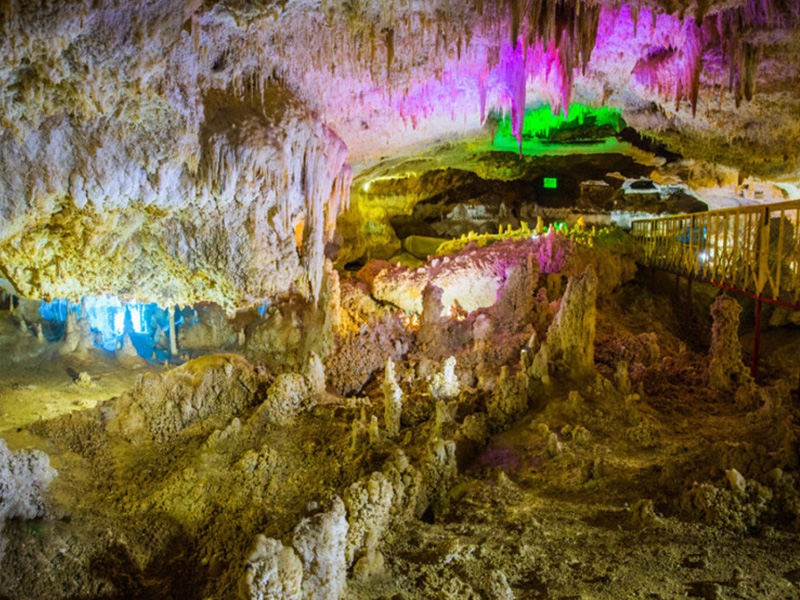
Different Parts of Katale Khor Cave
Katale Khor Cave is one of the caves in Iran that is divided into three sections. One section is a sports cave designated for cavers and rock climbers. In this section, you can enjoy rock climbing and have a great time in the cave. The recreational section of the cave covers an area of approximately two kilometers and is open for public visits. The cave has numerous main and sub-labyrinths, each named after objects in our surroundings due to their similarities.
“Meydan-e Shir Khabideh,” “Meydan-e Bisotun,” “Meydan-e Chehelston,” “Saraye Koohi,” “Meydan-e Panj Shir,” “Talar-e Aroos,” “Tunel-e Ghandili,” “Otagh-e Aqd,” “Pay-e Fil,” “Shotor-e Bajahaz,” “Aroos va Damad,” “Meydan-e Shaam,” “Do Jadugar,” “Nakhle Sookhte,” “Meydan-e Maryam Moghaddas,” and others are names of sections within the cave, named after their similarities to these objects.
The presence of clear and pure springs around the cave has made it even more attractive, turning it into one of the most unique caves in Iran.
Related post
Katale Khor Cave, an Unparalleled Cave in Zanjan
Travel to Kermanshah: Everything You Need to Know Before Your Trip!
Ali-Sadr Cave
In the beautiful province of Hamedan, there is a popular cave called Ali-Sadr Cave. This cave is among the Iranian caves that attract a lot of tourists due to its beauty and charm. Every year, many people visit the province of Hamedan to see this cave.
This mysterious cave is located in the village of Kabutar Ahang in Hamedan. Ali-Sadr Cave is the only marshy cave in Iran. Among tourists and cave explorers, it is known as the “Blue Cave” and is considered one of the world’s boat-ride caves. With a short walk inside the cave, you will reach flowing waters, and to reach the end of the cave, you need to board pedal boats. Along this mysterious path, be sure to pay attention to your surroundings. Numerous lanterns hang from the cave’s ceiling and sides. You can observe many strange shapes on the walls and surroundings of the cave and be amazed by the beauty you witness.
Among the local people of Hamedan, the cave is known as “Ali Sad Cave,” named after its usage as a dam in the past to prevent landslides. This cave stands out as a unique cave due to the presence of a water marsh and boat rides within it. The cave’s water is so clear that you can see several meters into its depths with the naked eye.
Best Season
If you travel to Hamedan province, make sure to have a unique experience of this pristine phenomenon for yourself and your companions. Ali-Sadr Cave is one of the caves of Iran, and its temperature remains constant throughout the seasons. You won’t feel the cold in this cave during winter. The cave also offers cool and pleasant air during autumn, summer, and spring, providing you with a delightful experience. One of the amenities of this cave is the presence of recreational centers outside the cave. There are numerous handicraft shops, local food stalls, and restaurants around the cave that will host you.
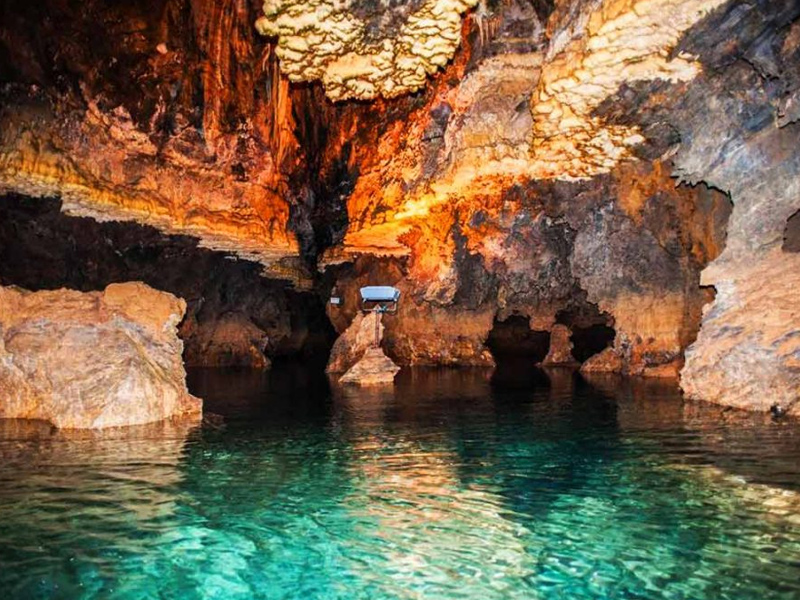
Iran’s Quri Qal’eh Cave
Quri Qal’eh Cave is one of the largest caves in Iran, with an area of approximately 12 kilometers discovered to date. This astonishing cave is located in Kermanshah province. Quri Qal’eh is registered as the first large blue cave in Asia. The suitable temperature of this cave makes it a great destination in all seasons. The cave is home to a rare species of bats called Koush Goushi and numerous yellow salamanders, adding to its beauty with its beautiful and unique lanterns. However, due to unregulated visits and lack of protection, the cave’s resident species have experienced a significant decrease in population. In this mysterious cave, you will encounter two phases.
Phase One
The first phase is named after the resemblance of its shapes to Hazrat Maryam (Virgin Mary). In this section, there is a large pool, and its beautiful and unique lanterns enhance the beauty of the cave. In this phase, you can also see shapes resembling camel humps, lions, and more.
Phase Two
The second phase of the cave is known as the bride’s hall. In this hall, there are shiny and spotless crystals that allow you to see your own footsteps as you walk on them. It is not without reason that this phase has become famous as the bridal hall of Iran’s caves. In this phase, there is a section called the prayer hall, which contains a dark narrow passage known as the “Barzakh.” At the end of the cave, there is a beautiful valley where you can sit and enjoy nature.
The tall and diverse trees there will attract you to them. The beauty of this area can convince you to spend hours with your friends and family. Among the other attractions of this mysterious cave are its four waterfalls, with heights ranging from 10 to 12 meters, at a depth of approximately 3,000 meters. The beautiful nature of this area, the forest landscape in one of Kermanshah province’s most scenic valleys, and the numerous springs are among the attractions that have made this cave famous among tourists. Create joyful and luxurious moments for yourself, your companions, and your family by traveling to this mysterious cave.
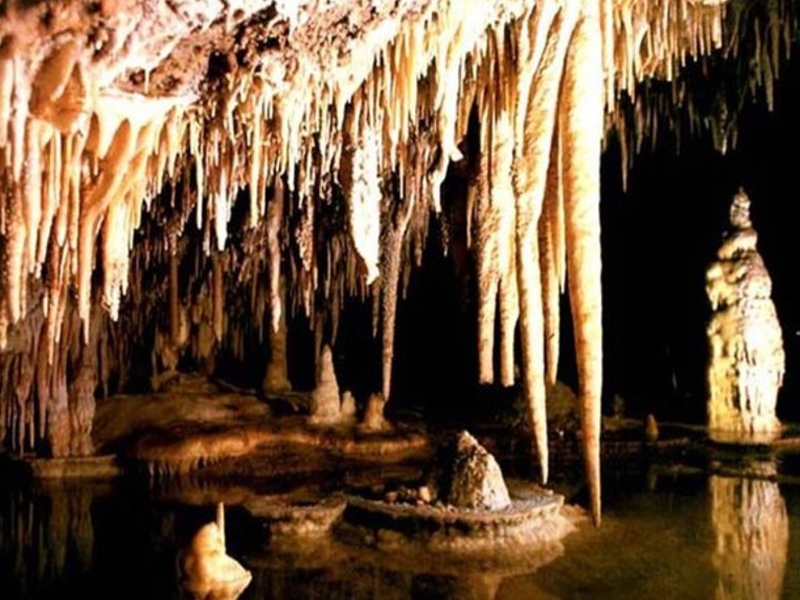
Salt Cave, Qeshm
Perhaps during your trip to Qeshm, you have visited the recreational and shopping centers that make this place full of attractions. However, in this discussion, we want to introduce you to one of the beautiful and fascinating caves of Iran located in Qeshm and bring a new pleasure of traveling to you.
Salt Cave is known as one of the wonders of the Persian Gulf. This cave is the longest salt cave in the world. It has a gentle slope, and in this beautiful and astonishing cave, you can witness beautiful reflections. The saltwater in the cave reflects images like a mirror, creating a beautiful and unique scenery in this salt cave.
The main bed of this colorful spring is red, and you can observe sedimentary clay deposits in it. This cave is one of the caves in Iran that is also known as Kani Cave among the locals because it is located in Kani village. In the cave, you can see streams of saltwater on the cave floor. The best time to visit this beautiful cave is from autumn to the end of spring. During these seasons, the pleasant and enjoyable weather away from the heat can double the pleasure of cave exploration for you.
Iran’s Bat Caves in Ilam
Another of Iran’s mysterious caves is the Bat Cave. This astonishing cave is located in Dehloran City, Ilam province. Various species of horseshoe bats and wide-winged bats live in this cave. If you are interested in studying different bat species, you can visit this cave and see the diversity of bat species up close and enjoy it.
Kafer Qal’eh Cave, Shirvan
This cave is one of the strangest caves in Iran. By entering this cave, you can see its difference from other caves. It may interest you to know that in the past, this cave was used as a residential place for refugees. The presence of stone carvings and stone walls in the cave, as well as the existence of a small cemetery next to the cave, is good evidence for our claim. In the past, antiquities and inscriptions have been found in this cave. This cave is one of the strange caves in Iran, although its beauty is not comparable to the beauty of other caves introduced, due to human habitation in this cave, it can be interesting for those who are curious to see how life was in a cave.
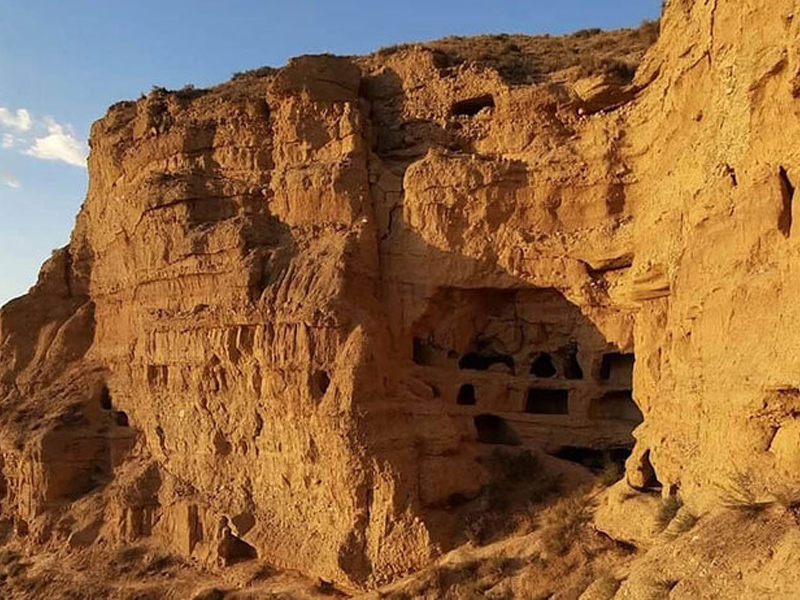
Dosar Cave, Yazd
Another mysterious cave in Iran is the Dosar Cave. This cave is considered the largest underground hall. The exact reason for naming this cave Dosar is still unknown, but it is said that one of the clues to this naming is the cave’s location between two peaks or the presence of two large rocks at the entrance of the cave. In this cave, various animals such as pigeons, bats, and beautiful swifts live. There are small and large rocks on the cave floor, indicating the collapse of parts of the cave.
Final words
Iran has numerous fascinating caves, each of which is unique and worth visiting. The diversity of these caves is so great that it can satisfy anyone’s taste, encouraging them to record the experience of cave exploration in their memoirs and enjoy a journey full of wonders and mysteries. With their unique geological formations, hidden chambers, underground rivers, and diverse ecosystems, these caves showcase the remarkable beauty and natural wonders that lie beneath the surface. It’s important to approach cave exploration with caution and respect for the fragile cave environment. Following safety guidelines and regulations, seeking guidance from experienced guides, and being mindful of the impact on the caves and their inhabitants will help preserve these natural wonders for generations to come.
FAQ
1- How many caves are there in Iran?
The exact number of caves in Iran is not known, as new caves are continuously being discovered. However, it is estimated that there are over 2,000 known caves in Iran, each with its own unique characteristics and geological formations.
2- Are the caves in Iran open to the public for exploration?
Many caves in Iran are open to the public and can be explored with the necessary permissions and guidance. Some popular caves, such as Ali-Sadr Cave in Hamedan and Katale Khor Cave in Zanjan, have well-developed infrastructure to accommodate visitors, including lighting, walkways, and guided tours. However, some caves are more remote and less accessible for exploration.
3- What are some notable features or attractions of the caves of Iran?
The caves of Iran offer a wide range of attractions and features. Some caves are known for their stunning stalactites and stalagmite formations, while others boast underground rivers, saltwater lakes, or unique geological structures. Many caves also provide habitats for diverse wildlife, including bats and rare species adapted to the cave environment.
